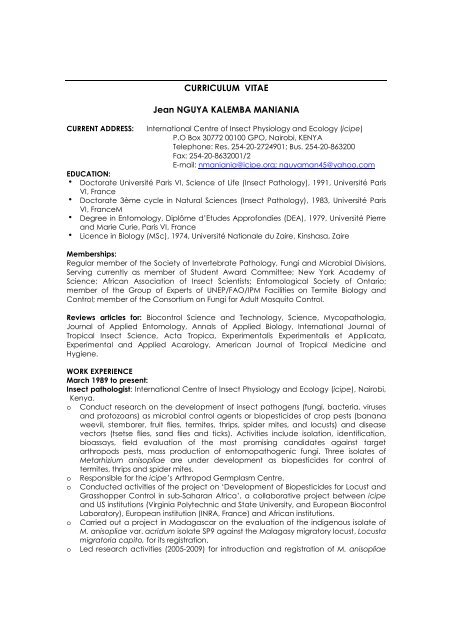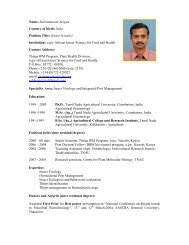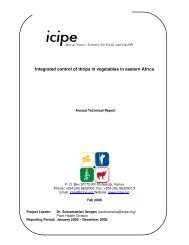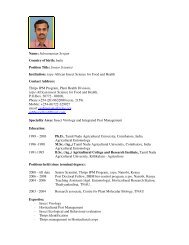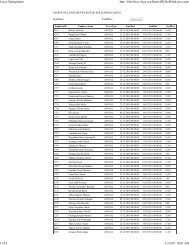CURRICULUM VITAE Jean NGUYA KALEMBA MANIANIA - icipe
CURRICULUM VITAE Jean NGUYA KALEMBA MANIANIA - icipe
CURRICULUM VITAE Jean NGUYA KALEMBA MANIANIA - icipe
- No tags were found...
You also want an ePaper? Increase the reach of your titles
YUMPU automatically turns print PDFs into web optimized ePapers that Google loves.
<strong>CURRICULUM</strong> <strong>VITAE</strong><strong>Jean</strong> <strong>NGUYA</strong> <strong>KALEMBA</strong> <strong>MANIANIA</strong>CURRENT ADDRESS: International Centre of Insect Physiology and Ecology (<strong>icipe</strong>)P.O Box 30772 00100 GPO, Nairobi, KENYATelephone: Res. 254-20-2724901; Bus. 254-20-863200Fax: 254-20-8632001/2E-mail: nmaniania@<strong>icipe</strong>.org; nguyaman45@yahoo.comEDUCATION:h Doctorate Université Paris VI, Science of Life (Insect Pathology), 1991, Université ParisVI, Franceh Doctorate 3ème cycle in Natural Sciences (Insect Pathology), 1983, Université ParisVI, FranceMh Degree in Entomology, Diplôme d’Etudes Approfondies (DEA), 1979, Université Pierreand Marie Curie, Paris VI, Franceh Licence in Biology (MSc), 1974, Université Nationale du Zaire, Kinshasa, ZaireMemberships:Regular member of the Society of Invertebrate Pathology, Fungi and Microbial Divisions.Serving currently as member of Student Award Committee; New York Academy ofScience; African Association of Insect Scientists; Entomological Society of Ontario;member of the Group of Experts of UNEP/FAO/IPM Facilities on Termite Biology andControl; member of the Consortium on Fungi for Adult Mosquito Control.Reviews articles for: Biocontrol Science and Technology, Science, Mycopathologia,Journal of Applied Entomology, Annals of Applied Biology, International Journal ofTropical Insect Science, Acta Tropica, Experimentalis Experimentalis et Applicata,Experimental and Applied Acarology, American Journal of Tropical Medicine andHygiene.WORK EXPERIENCEMarch 1989 to present:Insect pathologist: International Centre of Insect Physiology and Ecology (<strong>icipe</strong>), Nairobi,Kenya.o Conduct research on the development of insect pathogens (fungi, bacteria, virusesand protozoans) as microbial control agents or biopesticides of crop pests (bananaweevil, stemborer, fruit flies, termites, thrips, spider mites, and locusts) and diseasevectors (tsetse flies, sand flies and ticks). Activities include isolation, identification,bioassays, field evaluation of the most promising candidates against targetarthropods pests, mass production of entomopathogenic fungi. Three isolates ofMetarhizium anisopliae are under development as biopesticides for control oftermites, thrips and spider mites.ooooResponsible for the <strong>icipe</strong>’s Arthropod Germplasm Centre.Conducted activities of the project on ‘Development of Biopesticides for Locust andGrasshopper Control in sub-Saharan Africa’, a collaborative project between <strong>icipe</strong>and US institutions (Virginia Polytechnic and State University, and European BiocontrolLaboratory), European institution (INRA, France) and African institutions.Carried out a project in Madagascar on the evaluation of the indigenous isolate ofM. anisopliae var. acridum isolate SP9 against the Malagasy migratory locust, Locustamigratoria capito, for its registration.Led research activities (2005-2009) for introduction and registration of M. anisopliae
2oooooovar. acridum IMI330189 (Green Muscle®) into Madagascar for the control of. L.m.capito.Lead a team of experts (economist and mass production specialist) to evaluate theBiopesticide Production/Business Model Development in Madagascar in 2001.Developed systems (autodissemination devices) for infecting tsetse flies and fruit flieswith entomopathogenic fungi in the field.Lecture in insect pathology for the African Regional Postgraduate in Insect Science(ARPPIS), Ph.D. degree (1989-1995).Supervision of MSc. and Ph.D. students.Research proposal writing.RevDecember 1994 to 1997Acting Head, Pathology and Microbiology Department, <strong>icipe</strong>. Responsibilities includedthe day-to-day running of the unit and ensuring the scientific quality of research andprojects.August 1999 to present:Head of Entomopathology Unit, <strong>icipe</strong>. Responsibility included the day-to-day running ofthe unit and ensuring the scientific quality of research and projects.1987 to 1989Resident Fellow, Institut National de la Recherche Agronomique (INRA), Station deRecherche en Lutte Biologique, La Minière, France.o Conducted research on the effects of environmental factors on entomopathogenicfungi.o Studied the pathogenic activity of different developmental stages of fungus oninsect.o Responsible for organizing laboratories and supervision of postgraduate and Ph.D.students.1985 to 1987Resident Fellow, European Parasites Laboratory (EPL), a United States Department ofAgriculture, Agricultural Research Service (USDA/ARS) overseas laboratory based inFrance.o Carried out extensive surveys in France and Spain for isolation of insect pathogensfrom insects that have become major pests in the USA in order to develop them asbiological control agents.o Developed a portable device to isolate Entomophthorales in the field under sterileconditions.o Carried out bioassays on insects such as Nezara, Lygus and Empoasca.February 1984-1985Resident Fellow, EPL, under INRA/USDA-ARS agreement, La Minière, Paris, France.o Conducted research on isolation and identification of insect pathogens.o Actively participated in the installation of the laboratory of Insect Pathology incollaboration with Dr. Le Brun, Rhodes University, USA.1976 to 1979Assistant Lecturer, Université Nationale du Zaire, Institut Supérieur Pédagogique de KikwitDepartment of Biology/Chemistry, Kikwit, DRC. Teaching Biology, Anatomy-Physiologyand Embryology.
31977 to 1979oHead of Department of Biology/Chemistry. Responsibility: day-to-day running of thedepartment including ensuring the quality of teaching;o Coordinator of Sciences Section which included the departments ofMathematics/Physics and Biology/Chemistry. Responsibility includes the smoothrunning (time table, organization of exams) of the two departments.1974 to 1976Teacher, Secondary School, Mont Amba, attached to Université de Kinshasa, DRC.Teaching biology, technology and physics.1971 to 1972Teacher, Secondary School, Ngiri-Ngiri, Kinshasa, DRC. Teaching natural sciences.1967 to 1968Assistant accountant, SEDEC Trading, (UNILIVER Group), Kinshasa, DRC. I worked asassistant accountant in the sale departmentLIST OF PUBLICATIONSBook: S. Ekesi and N.K. Maniania (2007). "Use of entomopathogenic fungi in biologicalpest management" published by Research Signpost”, Kerala, India. 333p.Book chapters:Maniania N.K., Laveissière C., Odulaja A., Ekesi S., and Herren H.R. (2002)Entomopathogenic fungi as potential biocontrol agents for tsetse. In: Advances inMicrobial Control (Upadhyay R. ed.), pp. 145-163. Kluwer Academic/PlenumPublishers.Ekesi S. and Maniania N.K. (2002) Metarhizium anisopliae: An effective biological controlagent for the management of thrips in horti- and floriculture in Africa. In: Advances inMicrobial Control (Upadhyay R. ed.), pp. 164-180. Kluwer Academic/PlenumPublishers.Langewald J., Michell J., Maniania N.K. and Kooyman C. (2003) Microbial control oftermites in Africa. In: Biological Control in Integrated Pest Management Systems inAfrica P. Neuenschwander, Borgemeister C. and J. Langewald (eds.), pp. 227-242.CABI Wallingford.Tamò, M., Ekesi, S., Maniania, N.K. and Cherry, A. (2003) Biological control, a non-obviouscomponent of integrated pest management for cowpea. In: Biological Control inIntegrated Pest Management Systems in Africa. P. Neuenschwander, C.Borgemeister, J. and Langewald (eds), pp. 295-309. CABI Wallingford.Fitt G.P., Andow D.A., Carriere Y., Moar W.J., Schuler T.H., Omoto C., Kanya J., OkechM.A., Arama P. and Maniania N.K. (2004). Resistance risks and managementassociated with Bt maize in Kenya. In: Environmental Risk Assessment of GeneticallyModified Organisms. Volume 1: A case Study of Bt Maize in Kenya. A. Hilbeck andD.A. Andow (eds), pp. 209-250. CABI Wallingford.Maniania N.K., Nchu F. and Ekesi S. (2007) Fungal pathogens for biocontrol of ticks. In: Useof Entomopathogenic Fungi in Biological Pest Management, S. Ekesi and N.K.Maniania (eds), pp. 275-294. Research Signpost, Kerala, India.Ekesi S., Dimbi S. and Maniania N.K. (2007) The Role of Entomopathogenic Fungi in theIntegrated Management of Fruit Flies (Diptera: Tephritidae) with Emphasis on SpeciesOccurring in Africa. In: Use of Entomopathogenic Fungi in Biological Pest
4Management, S. Ekesi and N.K. Maniania (eds), pp. 239-274. Research Signpost,Kerala, India.Journal Articles:Maniania N.K. and Fargues J. (1984) Spécificité des Hyphomycètes entomopathogènespour les larves de lépidoptères Noctuidae. Entomophaga 29: 4451-464.Maniania N.K. and Fargues J. (1985) Susceptibility of the fall armyworm Spodopterafrugiperda to the fungal pathogens Paecilomyces fumosoroseus and Nomuraearileyi. Florida Entomologist 68: 178-183.Poprawski T.J., Robert P.H. and Maniania N.K. (1985) Susceptibility of the onion maggot,Delia antiqua (Diptera: Anthomyiidae) to the mycotoxin E. Canadian Entomologist117: 801-802.Riba G., Poprawski T.J. and Maniania N.K. (1986) Isoesterases variability amonggeographical populations of Beauveria bassiana (Fungi imperfecti) isolated fromMiridae (Heteroptera). In "Fundamental and Applied Aspects of InverterbratePathology" (R.A. Samson, J.M. Vlak and D. Peters Eds), Wageningen, TheNetherlands, pp. 205-209.Majchrowicz I., Poprawski T.J., Maniania N.K. and Robert P.H. (1990) Effects ofentomopathogenic and opportunistic fungi on Delia antiqua (Diptera:Anthomyiidae) at low relative humidity. Environmental Entomology 19: 1163-1167.Maniania N.K. (1991) Potential of some fungal pathogens for the control of pests in thetropics. Insect Science and its Application 12: 63-70.Maniania N.K. (1991) Susceptibility of Chilo partellus eggs to entomopathogenicHyphomycetes. Journal of Applied Entomology 112: 53-58.Maniania N.K. and Fargues J. (1992) Susceptibility of Mamestra brassicae (L.) andSpodoptera littoralis (Boisd.) (Lep., Noctuidae) larvae to the hyphomycetesPaecilomyces fumosoroseus (Brown and Smith) and Nomuraea rileyi (Samson) attwo temperatures. Journal of Applied Entomology 113: 518-524.Fargues J., Maniania N.K., Delmas J.C. and Smits N. (1992) Influence de la tempé- raturesur la croissance in vitro d'hyphomycètes entomopathogènes. Agronomie 12: 557-564.Fargues J. and Maniania N.K. (1992) Variabilité de la sensibilité de Spodoptera littoralis(Lep., Noctuidae) a l'hyphomycète entomopathogène Nomuraea rileyi.Entomophaga 37: 545-554.Maniania N.K. (1992) Pathogenicity of entomogenous fungi (Hyphomycetes) to larvae ofthe stem borers, Chilo partellus Swinhoe and Busseola fusca Fuller. Insect Scienceand its Application. 13: 691-696.Maniania N.K. (1993) Evaluation of three formulations of Beauveria bassiana for potentialcontrol of the stem borer Chilo partellus. Journal of Applied Entomology. 115: 266-272.Maniania N. K. (1993) Effectiveness of Beauveria bassiana (Bals.) Vuill. for control of thestem borer Chilo partellus (Swinhoe) in maize in Kenya. Crop Protection. 12: 601-604.Maniania N.K., Okello R.O., Oluoch R.O. and Akinyi J. (1993) Field evaluation of conidiaand pre-germinated conidia of Beauvereia bassiana (Bals.) Vuill. for the control ofChilo partellus (Swinhoe). Journal of Plant Protection in the Tropics 10: 131-136.Poprawski T.J., Robert P.-H. Robert and Maniania N.K. (1994) Contact toxicity of themycotoxin destruxin E to Empoasca vitis (Homoptera: Cicadellidae). Journal ofApplied Entomology 117: 135-143.Fargues J., Maniania N.K. and Delmas J.C. (1994) Infectivity of propagules ofPaecilomyces fumosoroseus during in vitro development to Spodoptera frugiperda.Journal of Invertebrate Pathology 64: 173-178.
Maniania N.K., Okello R.O., Oluoch R.O. and Odero T.A. (1994) Potential ofentomopathogenic hyphomycetes (Deuteromycotina) fungi for the control of thestem borer Chilo partellus (Lep., Pyralidae). Journal of African Zoology 108: 529-536.Maniania N.K. (1994) A laboratory technique for infecting adult tsetse with a fungalpathogen. Insect Science and its Application. 15: 421-426.Maniania N.K. (1998) A device for infecting adult tsetse flies, Glossina spp., with anentomopathogenic fungus in the field Biological Control 11: 248-254.Ekesi S., Maniania N.K., and Onu I. (1998) Antibiosis and antixenosis of two cowpeavarieties to the legume flower thrips. African Crop Science Journal 6: 49-59.Maniania N.K., Saxena K.N., and Odulaja A. (1998) Influence of three sorghum cultivarson the activity of Metarhizium anisoplaie (Mestch.) Sorok. against Chilo partellus(Swinhoe). Insect Science and its Application. 18, 45-52.Ekesi S., Maniania N.K., Onu I., and Lohr B. (1998) Pathogenicity of entomopathogenicfungi (Hyphomycetes) to the legume flower thrips, Megalurothrips sjostedti (Trybom)(Thysanoptera: Thripidae). Journal of Applied Entomology. 122, 629-638.Ekesi S., Maniania N.K., Ampong-Nyarko K., and Onu I. (1998) Potential of theentomopathogenic fungus, Metarhizium anisopliae (Metsch.) Sorokin for control ofthe legume flower thrips, Megalurothrips sjostedti (Trybom) on cowpea in Kenya.Crop Protection. 17, 661-668.Maniania N.K., and Odulaja A. (1998) Effect of species, age, and sex of tsetse onresponse to infection by Metarhizium anisopliae. Biocontrol. 43, 311-323.Ekesi S., Maniania N.K., Ampong-Nyarko K., and Onu I. (1999) Effect of temperature ongermination, radial growth and pathogenic activity of Metarhizium anisopliae(Metschnikoff) Sorokin and Beauveria bassiana (Balsamo) Vuillemin onMegalurothrips sjostedti (Trybom). Biocontrol Science and Technology. 9, 177-185.Maniania N.K. and Nadel D.J. (1999) Tsetse’s lethal path. Biocontrol News andInformation. 20, 7N-8N.Ekesi S., Maniania N.K., and Onu I. (1999) Effects of temperature and photoperiod ondevelopment and oviposition of the legume flower thrips, Megalurothrips sjostedti.Entomologia Experimentalis et Applicata 93, 149-155.Ekesi S., Maniania N.K., Ampong-Nyarko K., and Onu I (1999) Effect of intercroppingcowpea with maize on the performance of Metarhizium anisopliae against thelegume flower thrips, Megalurothrips sjostedti, and some predators. EnvironmentalEntomology.28, 1154-1161.Ekesi S, Maniania N.K. and Lwande W. (2000). Susceptibility of the legume flower thrips toMetarhizium anisopliae on different varieties of cowpea. Biocontrol. 45, 79-95.Ekesi S. and Maniania N.K. (2000). Susceptibility of Megalurothrips sjostedtidevelopmental stages to Metarhizium anisopliae and the effects of infection onfeeding, adult fecundity, egg fertility and longevity. Entomologia Experimentalis etApplicata. 94, 229-236.Ekesi S., Maniania N.K., Ampong-Nyarko K. and Akpa A.D. (2001) Importance of timing ofapplication of the entomopathogenic fungus, Metarhizium anisopliae for the controlof legume flower thrips, Megalurothrips sjostedti and its persistence in cowpea.Archive Phytopathology and Plant Protection 33, 431-445.Ekesi S., Adamu R.S. and Maniania N.K. (2001) Ovicidal activity of entomopathogenichyphomycetes to the legume pod borer, Maruca vitrata and the pod sucking bug,Clavigralla tomentosicollis. Crop protection 21, 589-595.Ekesi S., Maniania N.K. and Lux S.A. (2002) Mortality in three economically importantAfrican tephritid fruit fly puparia and adults caused by the entomopathogenic fungi,Metarhizium anisopliae and Beauveria bassiana. Biocontrol Science and Technology12, 7-17.Maniania N.K. (2002). A low-cost contamination device for infecting tsetse flies, Glossinaspp. with entomopathogenic fungus Metarhizium anisopliae in the field. BiocontrolScience and Technology 12, 59-66.5
Maniania N. K., Ekesi S. and Songa J.M. (2002) Managing termites in maize croppingsystem with the entomopathogenic fungus, Metarhizium anisopliae. Insect Scienceand its Application 22, 41-46.Maniania N.K., Ekesi S., Löhr B., and Mwangi F. (2001) Prospects for biological control ofthe western flower thrips, Frankliniella occidentalis with the entomopathogenicfungus, Metarhizium anisopliae, on chrysanthemum. Mycopathologia 155, 229-235.Maniania N.K., Sithanantham S., Ekesi S., Ampong-Nyarko K., Baumgaertner J., Löhr B.,and Matoka C.M. (2003) A Field Trial of the entomogenous fungus Metarhiziumanisopliae for control of onion Thrips, Thrips tabaci. Crop Protection 22, 553-559.Ekesi S., Maniania N.K. and Lux S.A. (2003) Effect of soil temperature and moisture onsurvival and infectivity of Metarhizium anosopliae to four tephritid fruit fly puparia.Journal of Invertebrate Pathology 83, 157-167.Dimbi S., Maniania N.K., Lux S.A., Ekesi S. and Mueke J.K. (2003) Pathogenicity ofMetarhizium anisopliae (Metsch.) Sorokin and Beauveria bassiana (Balsamo)Vuillemin, to three adult fruit fly species: Ceratitis capitata (Weidemann), C. rosa var.fasciventris Karsch and C. cosyra (Walker) (Diptera : Tephritidae). Mycopathologia156, 375-382.Dimbi S., Maniania N.K., Lux S.A., Ekesi S. and Mueke J.K. (2003) Host species, age andsex as factors affecting the susceptibility of the African Tephritid fruit fly species,Ceratitis capitata, C. cosyra and C. fasciventris to infection by Metarhiziumanisopliae. Journal of Pest Science. 76, 113-117.Maniania N.K. and Loehr B. (2005) Biopesticides in pest management systems: recentdevelopment and future needs in Africa. In International Symposium on Biopesticidesfor Developing Countries 2003, Turrialba, Costa Rica (Edited by Roettger U. andMuschler R.), pp 195-201.Maniania N.K. and Varela A.M. (2005) Production of biopesticides and botanicals inAfrica. In International Symposium on Biopesticides for Developing Countries 2003,Turrialba, Costa Rica (Edited by Roettger U. and Muschler R.), pp 117-125.Wekesa V.W., Maniania N.K., Knapp M. and Boga H.I. (2005) Pathogenicity of Beauveriabassiana and Metarhizium anisopliae to the tobacco spider mite Tetranychus evansi.Experiment. Appl. Acarol. 36, 41-50.Ekesi S., Maniania N.K., Mohamed S.A. and Lux S.A. (2005) Effect of soil application ofdifferent formulations of Metarhizium anisopliae on African tephritid fruit flies and theirassociated endoparasitoids. Biol. Contr. 35, 83-91.Makhfousse S., Maniania N.K., Russel-Smith A. and Niassy A. (2005) Diversité des termites(Isoptera) au Sénégal et leurs dégâts sur les cultures et périmètres reboisés. Int. J. Tr.Ins. Sci. 3, 147-158.Maniania N.K., Ekesi S., Odulaja A., Okech M.A and Nadel DJ. (2006) Prospects of afungus-contamination device for the control of tsetse fly Glossina fuscipes fuscipes.Biocontrol Science and Technology 16, 129-139.Wekesa V.W., Knapp M., Maniania N.K. and Boga H.I. (2006) Effects of of Beauveriabassiana and Metarhizium anisopliae on mortality, fecundity and egg fertility ofTetranychus evansi. J. Appl. Entomol. 130, 155-159.Maniania N.K., Ekesi S. (2006) Tsetse’s lethal path (Part II). Biocontrol News andInformation. 27, 17N-18N.Maniania N.K. and Takasu K. (2006) Development of microbial control agents at theInternational Centre of Insect Physiology and Ecology. Bulletin of the Institute ofTropical Agriculture Kyhushu University 29, 1-9.Ondiaka S, Maniania N.K., Nyamasyo G.H.N. and Nderi tu J.H. (2008) Virulence of theentomopathogenic fungi Beauveria bassiana and Metarhizium anisopliae to sweetpotato weevil Cylas puncticollis and effects on fecundity and egg viability. Annals ofApplied Biology 153, 41-48.6
7Maniania N.K., Bugeme D.M., Wekesa, V.W., Delalibera Jr. I. and Knapp M. (2008) Role ofentomopathogenic fungi in the control of Tetranychus evansi and Tetranychusurticae (Acari: Tetranychidae), pests of horticultural crops. Experimental and AppliedAcarology. 46, 259-274.Maniania N.K., Ouna E. and Vaughan J.V. (2008) Susceptibility of immature stages of thelocusts Schistocerca gregaria and Locusta migratoria migratorioides to themicrosporidium Johenrea locustae and effects of infection on feeding and fertility inthe laboratory. Biocontrol Science and Technology. 18, 913-920.Bugeme D.M., Maniania N.K., Knapp M. and Boga H.I. (2008) Effect of temperature onvirulence of Beauveria bassiana and Metarhizium anisopliae isolates to Tetranychusevansi. Experimental and Applied Acarology. 46, 275-285.Bugeme D.M., Knapp M., Boga H.I., Wanjoya A.K. and Maniania N.K. (2008) Influence oftemperature on virulence of fungal isolates of Metarhizium anisopliae and Beauveriabassiana to the two-spotted spider mite Tetranychus urticae. Mycopathologia. 167,221-227.Nchu F., Maniania N.K., Touré A., Hassanali A. and Eloff J.N. (2009) The use of asemiochemical bait to enhance exposure of Amblyomma variegatum (Acari:Ixodidae) to Metarhizium anisopliae (Ascomycota: Hypocreales). VeterinaryParasitology. 160, 279-284.Dimbi S., Maniania N.K. and Ekesi S.(2009) Effect of Metarhizium anisopliae inoculation onthe mating behavior of three 3 species of African Tephritid fruit flies, Ceratitiscapitata, Ceratitis cosyra and Ceratitis fasciventris. Biological Control. 50, 111–116.Mburu D.M., Ochola L., Maniania N.K., Njagi P.G.N., Gitonga L.M., Ndung’u M.W.,Wanjoya A.K. and Hassanali A. (2009) Relationship between virulence andrepellency of entomopathogenic isolates of Metarhizium anisopliae andBeauveria bassiana to the termite Macrotermes michaelseni. Journal of InsectPhysiology 55, 774–780.Vega, F.E., Goettel M.S., Blackwell M., Chandler D., Jackson M.A., Keller S., Koike M.,Maniania N.K, Monzón A., Ownley B.H., Pell J.K., Rangel D.E.N., and Roy H.E..(2009) Fungal entomopathogens: new insights on their ecology. Fungal Ecology,2, 149- 159.CONFERENCE ABTRACTSManiania N.K. and Fargues J. (1986) Infectivity of Paecilomyces fumosoroseus andNomuraea rileyi at two temperatures. IVth International Colloquium on InvertebratePathology and Microbial Control, Veldhoven, 18-24 August 1986, The Netherlands.Poprawski T.J., Maniania N.K. and Robert P.H. (1986) Entomocity of destruxin E to nymphsof the leafhopper, Empoasca vitis (Homoptera: Cicadellidae). IVth InternationalColloquium on Invertebrate Pathology and Microbial Control, Veldhoven, 18-24August 1986, The Netherlands.Riba G., Poprawski T.J. and Maniania N.K. (1986) Isoesterase variability amonggeographical populations of Beauveria bassiana (Fungi imperfecti) isolated fromMiridae. IVth International Colloquium on Invertebrate Pathology and MicrobialControl, Vedhoven, 18-24 August 1998, The Netherlands.Poprawski T.J. and Maniania N.K. (1986) Pathogenicity of fungus Paecilomycesfumosoroseus to parasited pupae of Muscae domestica. Workshop on ‘Dual Role ofPathogens and Parasites in Insect Control’, Behoust, 23 August 1986, France.Maniania N.K. (1989) Some fungal pathogens for the control of pests in the tropics.Second International Conference on Tropical Entomology, Nairobi, 31 July-4 August1989, Kenya.
Maniania N.K. (1989) Susceptibility of Chilo partellus eggs to entomopathogenicHyphomycetes. Eigth Annual Meeting and Scientific Conference of the AfricanAssociation of Insect Scientists (AAIS), Lusaka, 4-8 December, Zambia.Maniania N.K. (1990) Pathogenicity of entomogenous fungi (Hyphomycetes) to larvae ofthe stem borers, Chilo partellus (Swinhoe) and Busseola fusca Fuller. Vth InternationalColloquium on Invertebrate Pathology and Microbial Control, Adelaide, 20-24August 1990, Australia.Maniania N.K. (1991) Evaluation of three formulations of Beauveria bassiana for thecontrol of the stem borer Chilo partellus. Nineth Biannual Meeting and ScientificConference of the Association of Insect Scientists (AAIS), Accra, 23-27 September1991, Ghana.Maniania N.K. (1994) A laboratory technique for infecting adult tsetse with fungus. VIthInternational Colloquium on Invertebrate Pathology and Microbial Control and IIndInternational Conference on Bacillus thuringiensis, Montpellier, 28 August-2September 1994, France.Maniania N.K. (1995) Development of a system for infecting tsetse flies, Glossina spp., withentomogenous fungus in the field. Society for Invertebrate Pathology 28 th AnnualMeeting, Ithaca, New York, 16-21 July 1995, USA.Gitonga W., Eilenberg, J., Maniania N.K. and Ochiel G.R.S. (1996) The potential ofMetarhizium anisopliae (Metsch.) Sorok. and Beauveria bassiana (Bals.) Vuill. asbiological control agents of termite in Kenya. Society for Invertebrate Pathology 29 thAnnual Meeting and IIIth Colloquium on Bacillus thuringiensis, Cordoba, 1-6September 1996, Spain.Ekesi S., Maniania N.K., Ampong-Nyarko K., Lohr B. and Onu I. (1997) Field evaluation ofthe entomopathogenic fungus, Metarhizium anisopliae (Metsch.) Sorok. for thecontrol of legume flower thrips, Megalurothrips sjostedti (Trybom) on cowpea. JointCongress of the Entomological Society of Southern Africa (11 th congress) and theAfrican Association of Insect Scientists 12 th congress), Stellenbosch, 30 June-4 July1997, South Africa.Maniania N.K. and Nadel D.J. (1998) Effect of infection by Metarhizium anisopliae onmatting behavior of tsetse fly, Glossina morsitans morsitans. VIIth InternationalColloquium on Invertebrate Pathology and Microbial Control and IVth InternationalConference on Bacillus thuringiensis, Sapporo, 23-28 August 1998, Japan.Maniania N.K., Ekesi S., Ampong-Nyarko K., and Sithanamtham S. (1998) Metathripol,Metarhizium anisopliae-based bioinsecticide for biological control of thrips onvegetable and flower crops in Africa. VIIth International Colloquium on InvertebratePathology and Microbial Control and IVth International Conference on Bacillusthuringiensis, Sapporo, 23-28 August 1998, Japan.Maniania N.K., and Nadel, D.J. (1999) Prospects of contamination device for themanagement of tsetse flies, Glossina spp. 32 nd Meeting of the Society forInvertebrate Pathology, university of California at Irvine, 22-27 August 1999, USA.Ekesi S., Maniania N.K., Ampong-Nyarko K., and Onu I. (1999) Effect of intercroppingcowpea with maize on the performance of Metarhizium anisopliae againstMegalurothrips sjostedti and some predators. 32 nd Meeting of the Society forInvertebrate Pathology, university of California at Irvine, 22-27 August 1999, USA.Langewald J., Bokonon Ganta A., Gitonga W., Kooyman C., Maniania N.K., and MooreD. (1999) Developing Metarhizium anisopliae for termite control in Africa. 32 ndMeeting of the Society for Invertebrate Pathology, university of California at Irvine,22-27 August 1999, USA.Underwood K.L., Jackson C.W., Howse P., Saini R.K., and Maniania N.K. (1999) Thepotential of electrostatic powder formulation for the microbial control of tsetse flyand other invertebrate pests. 32 nd Meeting of the Society for Invertebrate Pathology,University of California at Irvine, 22-27 August 1999, USA.Maniania, N.K., and Nadel, D.J. (1999) Prospects of using entomopathogenic fungus in8
contamination devices for the management of tsetse flies, Glossina spp. 25 thMeeting of the International Scientific Council for Trypanosomosis Research andControl (ISCTRC), Mombasa, 27 September-1 October 1999, Kenya.Cherry A.J., Maniania N.K., and Oduor G. (2000) Microbial insecticides in Africa, currentuse and future prospects. 33 rd Meeting of the Society for Invertebrate Pathology,University of Guanajuato, 13-18 August 2000, Mexico.Langewald J., Bokonon Ganta A., Gitonga W., Kooyman C., and Maniania N.K. (2000)Developing Metarhizium anisopliae for termite control in Africa: strain selection andfirst trial results. 33 rd Meeting of the Society for Invertebrate Pathology, University ofGuanajuato, 13-18 August 2000, Mexico.Maniania N.K. (2001) Tsetse fly-pathogens and their potential use for its biocontrol.Symposium of the 34 th Meeting of the Society for Invertebrate Pathology,Noordwijkerhout, 25-30 August 2001, The Netherlands.Dimbi S., Ekesi S., Maniania N.K., Lux S.A. and Nzenz N. (2001) Alternative paradigm forfruit fly management based on entomopathogenic fungi. 34 th Meeting of theSociety for Invertebrate Pathology, Noordwijkerhout, 25-30 August 2001, TheNetherlands.Langewald J., Bokonon Ganta A., Gitonga W., Kooyman C., and Maniania N.K. (2001)Fungal control of termites: A viable option for Africa? 34 th Meeting of the Society forInvertebrate Pathology, Noordwijkerhout, 25-30 August 2001, The Netherlands.Ekesi S. and Maniania N.K. (2001) Fungal biocontrol of thrips. 34 th Meeting of the Societyfor Invertebrate Pathology, Noordwijkerhout, 25-30 August 2001,The Netherlands.Maniania N.K. (2002) Biology and management of termites in structures and agriculture.UNEP/WHO Sub-regional Workshop on the Reduction/Elimination and Managementof Pesticides in the Context of the Stockholm and Basel Conventions and RelatedActivities of WHO’s Regional Office for Africa, 4-8 November, 2002, Pretoria, SouthAfrica.Cherry A., Maniania N.K. and Odouor G. (2003) Microbial control in Africa: current statusand future. Bi-annual meeting of the Association of Insect Scientists (AAIS), Nairobi, 9-13 June 2003, Kenya.Wafula W.V., Maniania N.K., Markus K. and Boga H. (2003) Pathogenic fungi as potentialcontrol agents for tobacco red mite Tetranycus evansi. Bi-annual meeting of theAssociation of Insect Scientists (AAIS), Nairobi, 9-13 June 2003, Kenya.Maniania N.K., Vaughan L.J., Osir E.O. and Ouna E.O. (2003) Virulence and developmentof the microsporidium Johenrea locustae in two locust species: Schistocercagregaria and Locusta migratoria. 36 th Annual Meeting of the Society for InvertebratePathology, Burlington, 26-30 July 2003, USA.Maniania N.K. (2003) Biology and management of termites in structures and agriculture.UNEP/WHO Sub-regional Workshop on the Reduction/Elimination and Managementof Pesticides in the Context of the Stockholm Convention on Persistent OrganicPollutants and Related Activities of WHO, 6-9 October 2003, Tunis, Tunisia.Maniania N.K. (2003) Integrated vector management: tsetse fly as case study.UNEP/WHO Sub-regional Workshop on the Reduction/Elimination and Managementof Pesticides in the Context of the Stockholm Convention on Persistent OrganicPollutants and Related Activities of WHO, 6-9 October 2003, Tunis, Tunisia.Maniania N.K. and Löhr B. (2003) Biopesticides and Pest Management System, recentdevelopment and future needs in Africa. International Symposium on Biopesticdesfor Developing Countries, 28-30 October 2003, Turrialba, Costa Rica.Maniania N.K. and Varela A. (2003) Production of Biopesticides in Africa. InternationalSymposium on Biopesticdes for Developing Countries, 28-30 October 2003, Turrialba,Costa Rica.9
10Maniania N.K., Ekesi S. and Lwande W. (2003) Tritrophic interactions: plant-insectentomopathogenicfungus. Annual Meeting of the Entomological Society ofOntario, 28-30 November 2003, Guelph, Canada.Maniania N.K. (2004) Controlling termites without POPs. UNIDO/SP-IPM Workshop on TheSearch for Alternatives to Banned/Restricted POPs, 9-13 February 2004, Cotonou,Benin.Herren H.R and Maniania N.K. (2004) Bacillus thuringiensis production factory at theInternational Centre of Insect Physiology and Ecology, Nairobi, Kenya. UNIDO/SP-IPMWorkshop on The Search for Alternatives to Banned/Restricted POPs, 9-13 February2004, Cotonou, Benin.Maniania N.K. (2005) Third UNEP/FAO Expert Meeting on Termite Biology andManagement, 1-4 February 2005, Geneva, Switzerland.Maniania N.K. (2005) Control of Locust and Grasshopper Project Small Group Meeting,10-11 October 2005, Dakar, Sénégal.Maniania N.K. Tsetse fly-pathogens and their potential in biological control. The Role ofPathogens and Symbionts in Tsetse SIT, 6-10 March 2006,Vienna, Austria.Maniania N.K., Nchu F. and Ekesi S. (2007) Fungal pathogen for biocontrol of ticks. 40 thAnnual Meeting of the Society for Invertebrate Pathology and 1 st International Forumon Entomopathogenic Nematodes and Symbiotic Bacteria, Quebec, 12-16 August2007, Canada.Mwangi D.M., Maniania N.K., Hassanali A., Njagi P.A., Gitonga L.M. and Ndungu M.W.(2007) Avoidance of entomopathogenic strains of Metarhizium anisoplliae bytermites: An evolutionary perspective. 40 th Annual Meeting of the Society forInvertebrate Pathology and 1 st International Forum on entomopathogenicNematodes and Symbiotic Bacteria, Quebec, 12-16 August 2007, Canada.Maniania N.K., Nchu F., Dimbi S. and Ekesi S. (2008) Semiochemicals: A Companion toEntomopathogenic Fungi? Semiochemicals in the Insect Pest and Disease VectorManagement: the African Perspective SEMIO-08, 11-15 February 2008, Arusha,Tanzania.Maniania N.K., Nchu F., Dimbi S. and Ekesi S. (2008) Entomopathogenic fungi vssemiochemicals: Mutualistic affair against pest. XXIII International Congress ofEntomology, 6-12 July 2008, Durban, South Africa.Mburu M.D., Ochola L. and Maniania N.K. (2008) Termite-fungus interactions: Aresemiochemicals involved in the defense behaviour of the termite Macrotermesmichaelseni? XXIII International Congress of Entomology, 6-12 July 2008, Durban,South Africa.Rajaonarison J.J.H., Maniania N.K., Njaka R. and Ramiliarijaona S. (2009) Successfulintroduction of Green Muscle® into Madagascar for the control of the migratorylocust Locusta migratoria capito. 42 nd Annual Meeting of the Society for InvertebratePathology, Utah, 16-20 August, 2009, USA.Mwangi D. M., Maniania N.K., Hassanali A., Njagi P.A., Gitonga L.M. and Ndungu M.W.(2009) Identification and blend effects of repellent volatiles of entomopathogenicfungi towards the termite Macrotermes michaelseni. 42 nd Annual Meeting of theSociety for Invertebrate Pathology, Utah, 16-20 August, 2009, USA.SEMINARS AND WORKSHOPSSeminars• ‘Yes’ Mr. Fungus can do it. Pathfast International Floriculture Seminar, Nairobi, March15-17, 1998.• Prospects of entomopathogenic fungi for biological control of thrips in horticulture.
11FPEAK Seminars, Hortec 1998, Nairobi, March 18-20, 1998.Workshops• Dual Role of Pathogens and Parasites in Insect Control. August 23, 1986, Béhoust,France.• Microbial Control of Storage Pests. November 30-December 2, 1998, Cotonou, Benin• Development of Biopesticides for Grasshopper and Locust Control in Sub-SaharanAfrica. December 8-10, 1999, Blacksburg, Virginia.• Biological control pests with entomopathogenic fungi. Use of Bacillus thuringiensisbasedBiopesticides for the Pest/Vector Management in Africa. November 10-19,1999, Nairobi, Kenya.• Biological control of tsetse flies. Tsetse Management. September 11-Otober 6, 2000,Nairobi, Kenya.• Managing termites in maize agro-ecosystem with entomopathogenic fungus,Metarhizium anisopliae. International Workshop and Conference on the Status andAdvances in Biological Control of Cereal Stemborers in Africa. October 16-20, 2000,Nairobi, Kenya.• Co-chair of the symposium on "Fungal Biocontrol of Tropical Insect Pests", 34 thMeeting of the Society for Invertebrate Pathology, Noordwijkerhout, 25-30 August2001, The Netherlands.• GMO Guidelines. November 25-29, 2002, Nairobi, Kenya.RESEARCH INTERESTS• Insect Pathology.• Development of insect pathogens as alternatives to reduce insecticide inputs inagriculture.• Development of delivery systems to autodisseminate entomopathogenic fungi forthe control of insect pests and disease vectors in the field.• Mass production of fungal pathogens and formulation.• Tritrophic interactions plant/pathogen/insect.MSc. And Ph.D. STUDENT SUPERVISIONSix MSc. and ten PhD students form different nationalities and different universities havegraduated under my supervision and other students are still undertaking research undermy supervision.LANGUAGESFrench: spoken and written (fluent).English: spoken and written (fluent).Kikongo: spokenLingala: spokenAWARDS• Fellowship, Ministry of French Cooperation: 1979-1983.• Fellowship, French Institut National de la Recherche Agronomique (INRA), France :1987-1989.• Fellowship, Japan Society for the Promotion of Science (JSPS), September 15-30, 2005.


